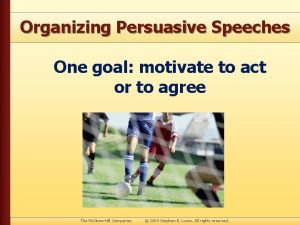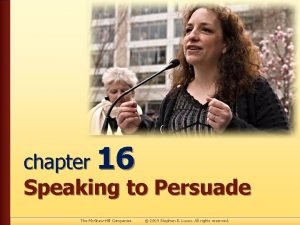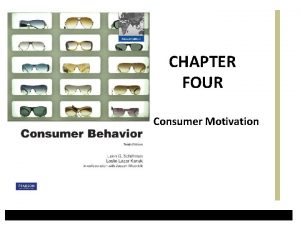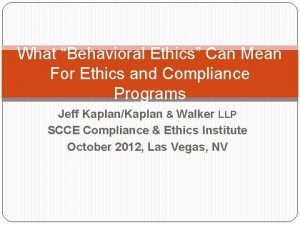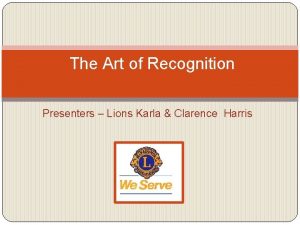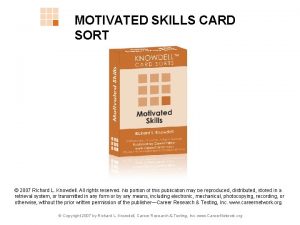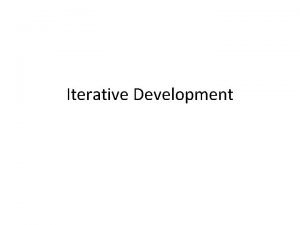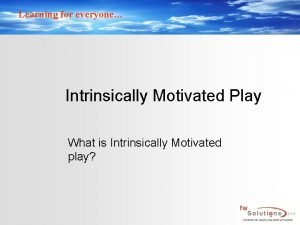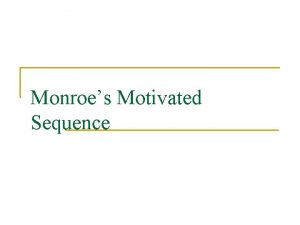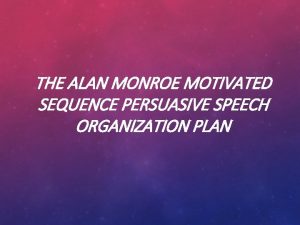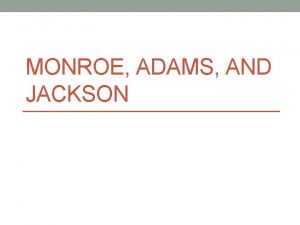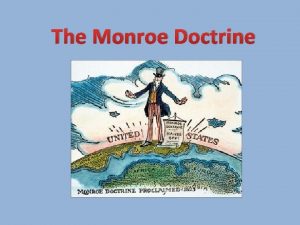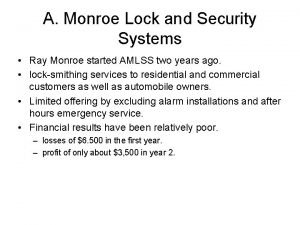Monroes Motivated Sequence Alan H Monroe a Purdue













- Slides: 13

Monroe's Motivated Sequence • Alan H. Monroe, a Purdue University professor, used the psychology of persuasion to develop an outline for making speeches that will deliver results. It's now known as Monroe's Motivated Sequence. • This is a well-used and time-proven method to organize presentations for maximum impact. You can use it for a variety of situations to create and arrange the components of any message.

Get the attention of your audience. • Use storytelling , humor, a shocking statistic, or a rhetorical question – anything that will get the audience to sit up and take notice. What is Business Storytelling? • People tell business stories to communicate and connect with employees, customers, colleagues, partners, suppliers, and the media. Business stories differ from regular stories, in that you tell them with an objective, goal, or desired outcome in mind, rather than for entertainment •

Establish the Need • Convince your audience there's a problem. This set of statements must help the audience realize that what's happening right now isn't good enough – and it needs to change. • Use statistics to back up your statements. • Talk about the consequences of maintaining the status quo and not making changes. • Show your audience how the problem directly affects them.

Apathy/lack of interest is the problem. • Safety harnesses sit on the floor when the worker is 25 feet above ground. Ventilation masks are used more to hold spare change than to keep people safe from dangerous fumes. Consequences. Ignoring safety rules caused 162 worker deaths in our province/state last year.

Step Three: Satisfy the Need • Introduce your solution. How will you solve the problem that your audience is ready to address? This is the main part of your presentation. It will vary significantly, depending on your purpose. • Discuss the facts. • Elaborate and give details to make sure the audience understands your position and solution. • Clearly state what you want the audience to do or believe. • Summarize your information from time to time as you speak. • Use examples, testimonials, and statistics to prove the effectiveness of your solution. • Prepare counterarguments to anticipated objections.

Step Four: Visualize the Future • Describe what the situation will look like if the audience does nothing. The more realistic and detailed the vision, the better it will create the desire to do what you recommend. Your goal is to motivate the audience to agree with you and adopt similar behaviors, attitudes, and beliefs. Help them see what the results could be if they act the way you want them to. Make sure your vision is believable and realistic. • You can use three methods to help the audience share your vision:

• Positive method – Describe what the situation will look like if your ideas are adopted. Emphasize the positive aspects. • Negative method – Describe what the situation will look like if your ideas are rejected. Focus on the dangers and difficulties caused by not acting. • Contrast method – Develop the negative picture first, and then reveal what could happen if your ideas are accepted

Visualization • Picture a safe and healthy workplace for everyone. Contrast Method/Negative • Method. Continue the status quo (keep doing the same thing), and someone will be seriously injured. Picture yourself at a colleague's funeral. You were right beside him when he decided not to wear his safety harness. How do you face his wife when you know you were right there and didn't say anything.

Positive Method • Consider the opposite. Imagine seeing your co-worker receive an award for 25 years of service. Feel the pride when you teach safety standards to new workers. Share the joy of your team's rewards for an outstanding safety record.

Step Five: Action/Actualization • Your final job is to leave your audience with specific things they can do to solve the problem. You want them to take action now. Don't overwhelm them with too much information or too many expectations, and be sure to give them options to increase their sense of ownership of the solution. This can be as simple as inviting them to have some refreshments as you walk around answer questions.

• For very complex problems, the action step might be getting together again to review plans. Action/Actualization. Review your safety procedure simmediately • . Invitation. I've arranged a factory tour after lunch. Everyone is invited to join us. Your insights will really help us identify areas that need immediate attention. If you're unable to attend this afternoon, I've left some pamphlets and business cards. Feel free to call me with questions, concerns, and ideas

Key Points • For some of us, persuasive arguments and motivational speaking come naturally. The rest of us may try to avoid speeches and presentations, fearing that our message won't be well received. Using Monroe's Motivated Sequence, you can improve your persuasive skills and your confidence.

• Get the attention of your audience, create a convincing need, define your solution, describe a detailed picture of success (or failure), and ask the audience to do something right away.
 How to organize a persuasive speech
How to organize a persuasive speech Youtu bev
Youtu bev Mc-graw hill
Mc-graw hill Monroe's motivated sequence
Monroe's motivated sequence Define motivated forgetting
Define motivated forgetting Motivation process
Motivation process Actions and their consequences examples
Actions and their consequences examples Lions are motivated by recognition
Lions are motivated by recognition Knowdell motivated skills card sort
Knowdell motivated skills card sort When abigail threatens betty, abigail is motivated by her
When abigail threatens betty, abigail is motivated by her Define motivated forgetting
Define motivated forgetting Motivated energized and capable faculty
Motivated energized and capable faculty Motivated last thing you want do
Motivated last thing you want do Motivated learning for everyone
Motivated learning for everyone
